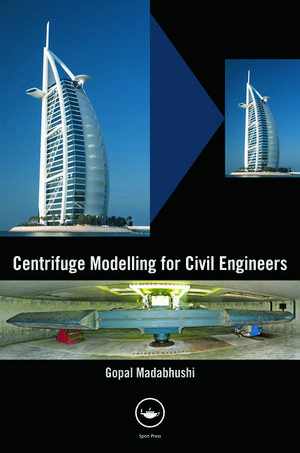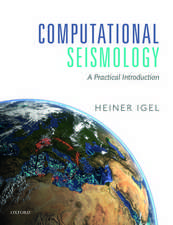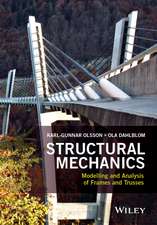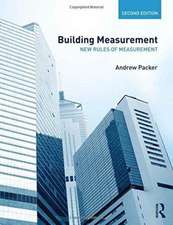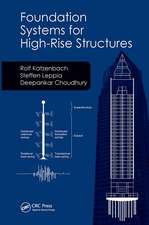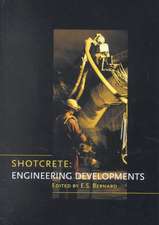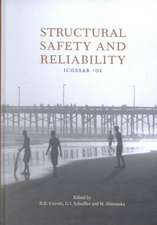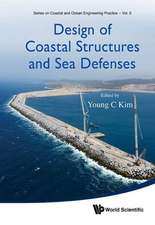Centrifuge Modelling for Civil Engineers
Autor Gopal Madabhushien Limba Engleză Paperback – 30 iul 2014
Presenting more than 25 years of teaching and working experience in a wide variety of centrifuge testing, the author of Centrifuge Modelling for Civil Engineers fills a need for information about this field. This text covers all aspects of centrifuge modelling. Expertly explaining the basic principles, the book makes this technique accessible to practicing engineers and researchers.
Appeals to Non-Specialists and Specialists Alike
Civil engineers that are new to the industry can refer to this material to solve complex geotechnical problems. The book outlines a generalized design process employed for civil engineering projects. It begins with the basics, and then moves on to increasingly complex methods and applications including shallow foundations, retaining walls, pile foundations, tunnelling beneath existing pile foundations, and assessing the stability of buildings and their foundations following earthquake-induced soil liquefaction. It addresses the use of modern imaging technique, data acquisition, and modelling techniques. It explains the necessary signal processing tools that are used to decipher centrifuge test data, and introduces the reader to the specialist aspects of dynamic centrifuge modelling used to study dynamic problems such as blast, wind, or wave loading with emphasis on earthquake engineering including soil liquefaction problems.
- Introduces the equipment and instrumentation used in centrifuge testing
- Presents in detail signal processing techniques such as smoothing and filtering
- Provides example centrifuge data that can be used for sample analysis and interpretation
Preț: 324.59 lei
Preț vechi: 432.25 lei
-25% Nou
Puncte Express: 487
Preț estimativ în valută:
62.12€ • 64.61$ • 51.28£
62.12€ • 64.61$ • 51.28£
Carte tipărită la comandă
Livrare economică 14-28 aprilie
Preluare comenzi: 021 569.72.76
Specificații
ISBN-13: 9780415668248
ISBN-10: 0415668247
Pagini: 324
Ilustrații: 214 black & white illustrations, 5 black & white tables
Dimensiuni: 156 x 234 x 20 mm
Greutate: 0.48 kg
Ediția:1
Editura: CRC Press
Colecția CRC Press
ISBN-10: 0415668247
Pagini: 324
Ilustrații: 214 black & white illustrations, 5 black & white tables
Dimensiuni: 156 x 234 x 20 mm
Greutate: 0.48 kg
Ediția:1
Editura: CRC Press
Colecția CRC Press
Public țintă
Postgraduate, Professional, and UndergraduateCuprins
Modern geotechnical engineering design in civil engineering. Need for numerical and physical modelling. Uniform circular motion. Principles of centrifuge modelling. Geotechnical centrifuges: Some design considerations. Errors and limitations in centrifuge modelling. Centrifuge equipment. Centrifuge instrumentation. Centrifuge data acquisition systems. Shallow foundations. Retaining walls. Pile foundations. Modelling the construction sequences. Dynamic centrifuge modelling. References.
Recenzii
"The author, who is the current Director of the Schofield Centre, has summarised his experience of over 25 years and the wealth of knowledge in this specialist area accumulated at that institution into this book. Traditionally imparted exclusively for institutions with research centres of excellence in centrifuge modelling, this book makes this knowledge and know-how of modern geotechnical centrifuge modelling technology readily accessible to the wider civil engineering community… graduate students would find it an essential reference when embarking on their centrifuge modelling research. Practicing engineers who wish to learn about centrifuge modelling or who are about to launch into solving complex geotechnical problems would find this book readable and informative. Certainly, a worthwhile investment…"
—Proceedings of the Institution of Civil Engineers
"This book will be very useful for research students. In most of the other books, very few topics are covered related to centrifuge modelling. However, in this book, a lot of important topics such as basic principles, limitation of centrifuge modelling, sample preparation, in-flight sample property determination, data acquisition, and applications in various areas are discussed. In this respect, the book is a complete package to researchers in this area as well as civil engineers who are keen to learn advanced physical modelling techniques."
—Dr. Pradipta Chakrabortty, Indian Institute of Technology Patna
"It is written in an engaging and accessible manner that will be particularly useful in making non-specialists aware of the benefits and applicability of centrifuge modelling to problems of geotechnics and soil-structure interaction. In this way, I believe it will play an important role in increasing the visibility of the technique and its use by the civil engineering industry."
—Jonathan Knappett, University of Dundee, UK
—Proceedings of the Institution of Civil Engineers
"This book will be very useful for research students. In most of the other books, very few topics are covered related to centrifuge modelling. However, in this book, a lot of important topics such as basic principles, limitation of centrifuge modelling, sample preparation, in-flight sample property determination, data acquisition, and applications in various areas are discussed. In this respect, the book is a complete package to researchers in this area as well as civil engineers who are keen to learn advanced physical modelling techniques."
—Dr. Pradipta Chakrabortty, Indian Institute of Technology Patna
"It is written in an engaging and accessible manner that will be particularly useful in making non-specialists aware of the benefits and applicability of centrifuge modelling to problems of geotechnics and soil-structure interaction. In this way, I believe it will play an important role in increasing the visibility of the technique and its use by the civil engineering industry."
—Jonathan Knappett, University of Dundee, UK
Descriere
This book on centrifuge modeling begins with the basics then gradually moves on to methods and applications such as shallow foundations, retaining walls, and pile foundations. It moves on to increasingly complex ones such as tunneling beneath existing pile foundations or assessing the stability of buildings and their foundations following earthquake-induced soil liquefaction. It addresses the use of modern imaging techniques, as well as data acquisition and modelling techniques. It also explains the necessary signal processing tools that are used to decipher centrifuge test data.
